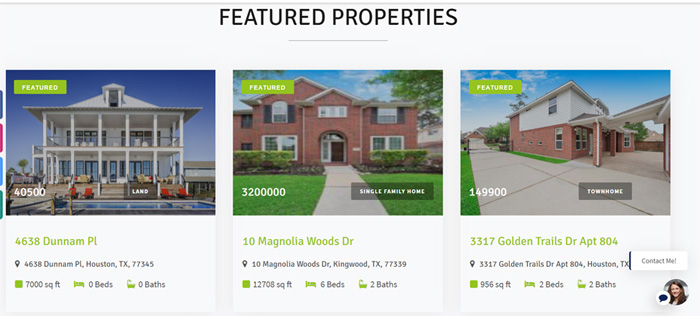Property listings are an integral part of a real estate website. Listings increase user engagement and make your website conversion-friendly. Most Realtors don’t know they can drive more organic traffic to their website by optimizing property listings for search engines.
SEO for real estate listings is a bit different from regular SEO and for this reason, you need to take additional steps to get more visibility for your listings in search results.
In this guide, I am going to explain how real estate listing SEO works:
Table of Contents
Schema markup for property listings
Schema markup – also known as structured data markup – is a type of website coding that helps Google and other search engines understand your content. If search engines understand your content, they will be able to determine relevancy and show it to users for relevant queries. In other words, by using Schema markup you can make it easier for search engines to understand and rank your content.
Let’s understand this with an example. Take a look at the Google search result for ‘California homes for sale’. You can see Google showing Open House dates for this search query.
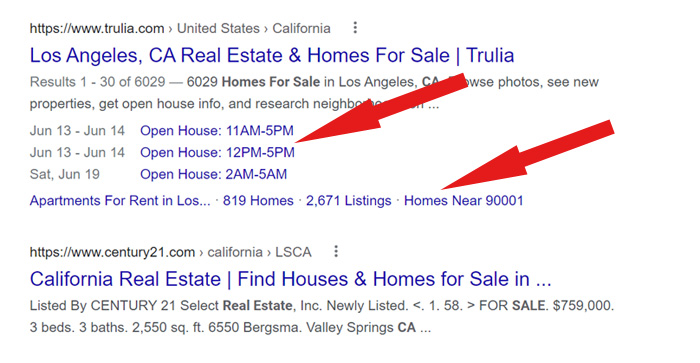
Google detected Schema-markup used in property listings by Trulia and showed Open House information for a few homes listed for sale in California.
Needless to say, you get more real estate in search engine results as your listing content is featured prominently. It increases the click-through rate (CTR).
The Schema markup is added to the HTML code of the website. There are schema markups that specifically used for real estate websites. Some of them include:
- RealEstateListing
- LeaseLength
- SingleFamilyResidence
- Accommodation
- Video
- Event
- FAQ
- Organization
In the above example, Google used the Event schema to show open house results. You can go through all types of Event-specific schema markup by clicking here.
Here is an example of how schema markup code looks like:
<script type=”application/ld+json”>
{
“@context”: “https://schema.org”,
“@type”: “SingleFamilyResidence”,
“name”: ” 34615 Sourwood Way – Detached Home”,
“description”: ” Gorgeous 3 bedroom, 2 bathroom, single story home with an expansive back yard in the community of Winchester! Enjoy an open floor plan with recessed lighting, formal living room, family room, and dining room.”,
“numberOfRooms”: 3,
“occupancy”: {
“@type”: “QuantitativeValue”,
“minValue”: 1,
“maxValue”: 5
},
“floorSize”: {
“@type”: “QuantitativeValue”,
“value”: 3000,
},
“leaseLength”: {
“@type”: “QuantitativeValue”,
“value”: 10,
“unitText”: “years”
},
“numberOfBathroomsTotal”: 5,
“numberOfBedrooms”: 6,
“permittedUsage”: “perfect for growing families.”,
“petsAllowed”: “Not Allowed”,
“yearBuilt”: 2001,
“address”: {
“@type”: “PostalAddress”,
“addressCountry”: “USA”,
“addressLocality”: ” Winchester”,
“addressRegion”: “California”,
“postalCode”: ” 92596″,
“streetAddress”: ” 34615 Sourwood Way”
},
“telephone”: “+1-000-000-0000”
}
</script>
If your website already doesn’t have schema markup, you should have it enabled with the help of an SEO professional. This will substantially increase the CTR and help you leverage the various features of search engine results including voice search and featured snippets.
Schema for IDX listings
Most IDX providers in the US and Canada use Schema markup for MLS listings. If you are choosing an IDX provider, you should make sure that they use Schema markup.
Unique property description
Google and other search engines value unique, informative, and original content.
For this reason, make sure that you describe the property in as many details as possible. The users should find it informative and relevant. They should be able to determine quickly if the property suits their requirement.
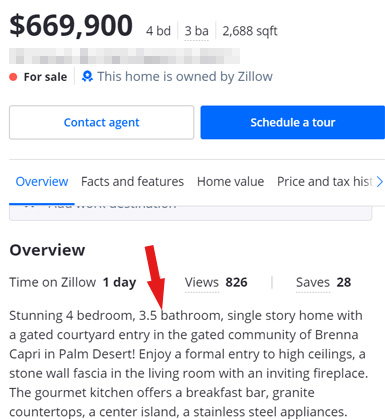
Most property listings on the internet have 100 or fewer words. You can stand out if you can increase the word length to 250 or more. However as already mentioned, make sure that the information is relevant.
Image SEO for listings
Every property listing has lots of images. You need to make sure the following things:
Alt tag: Alt tag is used by search engines to understand the relevancy of an image. It’s a type of short description that you can provide when you upload an image. This description should be relevant to the image. You can use keywords that you believe the potential visitors will use when performing the search for your listing.
Here is what Alt tag looks like if you are using the WordPress platform.
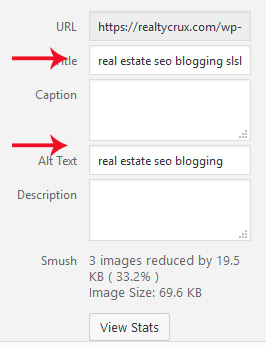
Another important thing to consider is that large images slow down page load speed. If the property listing images take too long to load, this will provide a poor user experience. Google and other search engines now value user experience more than anything, so you need to make sure that the listing images load fast on your website.
You can optimize the images by decreasing their file size. This will speed up the load time. If your website is on WordPress, there are plenty of plugins to help you decrease image load time. Alternatively, you can hire a real estate website developer to do this for you.
Meta description for real estate listings
Meta title and meta description are types of HTML tags that help Google and users understand the content of a webpage. Your meta title and description can potentially be shown in the search results. So, if you optimize them properly, it will increase CTR. By using the right meta description, you can tell search engine users that your page will offer what users are looking for.
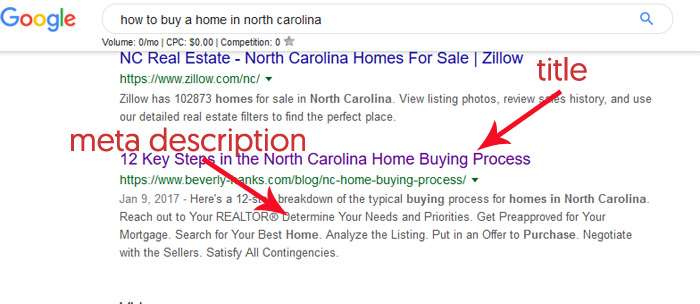
If you are using WordPress, you can install the Yoast SEO plugin. The plugin makes it very easy to add meta title and description as shown in the screenshot below:
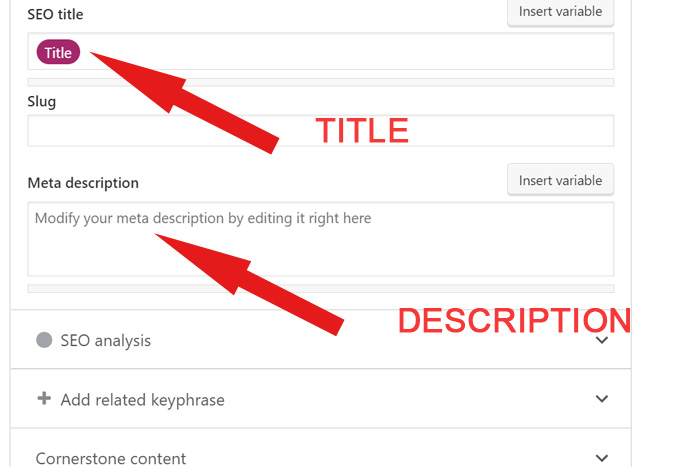
It’s extremely important that you use a unique meta title and description for each listing – in fact, for each page of your website. Duplicate descriptions might cause a Google penalty.
The word length for the meta title shouldn’t be more than 60 characters. The limit is 155 characters for a meta description.
Related property listings
Have you ever noticed a section showcasing ‘Similar Products’ on the product page of an eCommerce website?
Why do eCommerce websites display ‘Similar Products’?
Well, this plays an important role in SEO as well as user experience.
The user engagement increases substantially when they visit multiple web pages on your website. It increases ‘Time on Site’ and decreases ‘Bounce Rate’. Both help boost SEO.
You can use this strategy for property listing pages as well.
On a property listing page, you can display a section dedicated to similar or related listings. You can sort similar properties based on price range, location, number of bedrooms or bathrooms, square footage, etc.
In conclusion
You can get free organic traffic by optimizing your real estate listings for search engines. Real estate listings SEO is something you can’t afford to ignore because listings are an important element of a real estate website. By using Schema markup and meta and optimizing images and property descriptions, you can increase the visibility of your listings in search engines.
